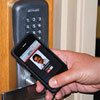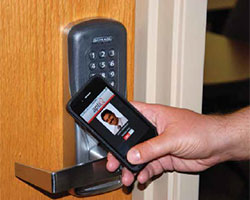
Mobile Discussion
In the near future, many will trade card credential to use their own smartphone for access control
- By Jeremy Earles
- Feb 01, 2013
 Using mobile devices is common behavior for consumers and businesspeople.
In fact, 5.9 billion of us—87 percent of the world’s
population—are mobile subscribers for one type of device or
another, many of us using two or more. One visit to an airport
and a glance at all the people working their wireless computers,
smartphones, iPads and Kindles will tell you that mobile computing is an essential
practice today. Mobile use has begun to permeate the consumer market in ways
beyond simple communication, Web browsing or ordering from e-stores.
Using mobile devices is common behavior for consumers and businesspeople.
In fact, 5.9 billion of us—87 percent of the world’s
population—are mobile subscribers for one type of device or
another, many of us using two or more. One visit to an airport
and a glance at all the people working their wireless computers,
smartphones, iPads and Kindles will tell you that mobile computing is an essential
practice today. Mobile use has begun to permeate the consumer market in ways
beyond simple communication, Web browsing or ordering from e-stores.
Today, when you’re not home, you can monitor your house through your Webenabled
computer or smartphone. You can check the status of your door locks and
grant entry to your home. You can conserve energy and save money by controlling
your lights and thermostat. Contractors are already creating the infrastructure for
such services in many new home constructions.
As they use mobile applications in other aspects of their lives, students entering
the workforce will fuel demand for increased use of their smartphones. They
will expect office buildings, technical campuses and services to be mobile-friendly.
They won’t want to remember and manage multiple cards, items and ID credentials
when they could simply use their smartphone to do it all.
Why All the Talk about NFC?
Near field communication (NFC) provides simplified transactions, data exchange
and wireless connections between two devices in close proximity to each other,
usually by no more than a few centimeters. It is expected to become a widely-used
system for making payments by smartphone in North America. Many smartphones
currently on the market already contain embedded NFC chips that can
send encrypted data a short distance—near field—to a reader located, for instance,
next to a retail cash register. Shoppers who have their credit card information
stored in their NFC smart phones can pay for purchases by waving their
smart phones near or tapping them on the reader, rather than bothering with
their actual credit card.
NFC technology in smartphones can be used to emulate smart credentials, allowing
use of a mobile phone for entry into secure areas. To turn a smartphone
into an access control credential, one simply downloads an app, such as aptiQmobile
from Schlage. The Web-based key management system then sends access
control credentials to the NFC-enabled smart phone, which the owner then uses
to retrieve the secure mobile key that was set up by the smartphone owner’s access
control site administrator. To enter buildings, students simply open the aptiQmobile
app and tap their phone to the smart reader on the wall in the same way that
they would present their One Card campus ID badge. It is secure and easy to use.
Many end users are excited about this new technology and its future use in the
marketplace. Like smart cards and biometrics, the early adaptors have been on
college campuses, ready to bring the technology to the commercial market along
with themselves and their degrees. Already using smartphones as a card credential
at college, they will want to do likewise once they are in the job market.
The desire to use smart phones as credentials is backed by studies. Three research
projects were conducted by Ingersoll Rand Security Technologies among
1,300 students and decision makers across 980 U.S. colleges and universities, both
public and private, 2-year and 4-year, in May 2011. Researchers found that twothirds
of American college students are interested in using their mobile phone in
place of an ID card. Students feel they are less likely to lose their phone than an
ID card. They know that ID cards are shared; phones aren’t. Using a phone as a
credential also offers the ability to remotely erase credential data in case it’s lost
or stolen, providing an extra layer of security.
NFC at Villanova and the University of San Francisco
Since November 2011, Villanova University students and staff have been using the
Web-based service along with NFC and their own personal smart phones as their
credential to access dormitories, academic buildings and administration offices.
In a survey among the students in the Villanova trial, more than 70 percent stated
they would prefer to use their phone instead of a badge to enter buildings.
The NFC credential integrates with Villanova’s CS Gold campus card system
from CBORD. CS Gold fully supports NFC credentials and seamlessly integrates
with the aptiQmobile Web service, so the credential download process is simple. To
use the credentials, students simply install and open the One Card app and present
the phone to the reader. Access is quick, easy and secure.
“Today’s students are so technologically advanced that it is second nature for
them to put everything on their phones and, most of the time, it’s already in their
hands while walking across campus,” said Kathy Gallagher, Villanova director of
card services. “We want to provide our students the utmost in convenience and
flexibility through the technology we offer. It’s easier for students to use an app on
their phone versus digging for their card.”
In another successful roll-out of NFC-enabled campus card credentials, the
University of San Francisco uses student smartphones for door access and for
spending at laundry terminals. USF’s systems approach integrates all aspects of
a physical security solution including campus card programs, biometrics, access
control, video surveillance systems, incident response and notification systems.
USF chose such a convergence model to increase crime prevention, respond to
incidents in progress with as much information as possible and alert the community
when incidents are in progress through an effective, multi-layer approach and to improve their investigative tools. USF integrates its NFC credential seamlessly with their CS Gold campus card system from CBORD using the aptiQmobile app.
“We want our use of near field communications to enhance the USF One Card
experience on many levels, which is why we introduced it for both door access and
laundry payment,” said Jason Rossi, director of One Card and campus security
systems, University of San Francisco. “Our students have embraced it, telling us
they prefer the convenience of their iPhones to digging for their One Cards. This
convenience is important to us, but equally important is the security of using their
existing contactless credentials, keeping our transactions secure. The combination
makes for a first-rate experience for our students and our staff.”
The enhanced convenience of using smartphones instead of badges extends to
administrators in charge of access control systems. Rather than having to print
physical ID badges for each student at enrollment time, a mobile “key” can be issued
online by the administrator directly to the student’s phone at any time. This
saves the university staff time, administrative costs and the expense of printers,
ink, card inventory and other needed supplies.
“Using smartphones as badges saves time that can be better spent on other
issues,” said John Bonass, Villanova systems manager. “Assigning the credential
to the students’ phone takes less work than printing and delivering a badge, and
since students are protective of their phones, this should lead to a greatly reduced
replacement rate. If a phone is lost or broken, a new ID can be reissued to the new
phone without even having the students come to our office.”
Villanova students in two residence halls were able to unlock doors to the front
door and dorm rooms, and contract for laundry services, vending machines and
the cafeteria with their own iPhones when they returned to campus this past fall
for the 2012/2013 school year. Over the summer, 80 Schlage AD-Series locks were
implemented in St. Claire and Jackson Halls, exclusive residences for seniors.
Schlage AD-Series locks let the university leverage its One Card system to provide
safe and secure passage throughout the campus. Administrators can provide
seamless integration with their present software, customize today’s access control
solution and easily migrate to future needs when required. Without replacing the
lock, or even taking it off the door, administrators can interchange readers and
network modules, integrate with existing “One Card” providers via the open architecture
platform, leverage their existing network infrastructure, easily upgrade
from an offline to a networked solution, change the credentials they are using at
any time and use future innovative technologies as they emerge.
There also is an added benefit. The university does not need to tear out its
readers when they decide to add NFC throughout the campus. If smart-enabled
AD-Series locks or XceedID smart readers are already installed, it’s simply a matter
of downloading the credentials to the students’ phones and they are ready to
go. If non-smart access technology is being used, multi-technology readers can be
installed to help ease into the transition by reading both the ID badges and the
smart phones.
All existing 13.56 MHz smart versions of the AD-Series locks and XceedID
smart card readers are already compatible with the aptiQmobile NFC technology.
No new readers are required.
The Future for NFC is Imminent
Many smartphones currently on the market are already NFC-enabled with more
models being launched every month. In the United States, more
than 40 million phones were expected to be NFC-enabled by
the end of 2012 and, according to a report by Market Research,
nearly half of all mobile phones will be NFC enabled by 2016.
This article originally appeared in the February 2013 issue of Security Today.